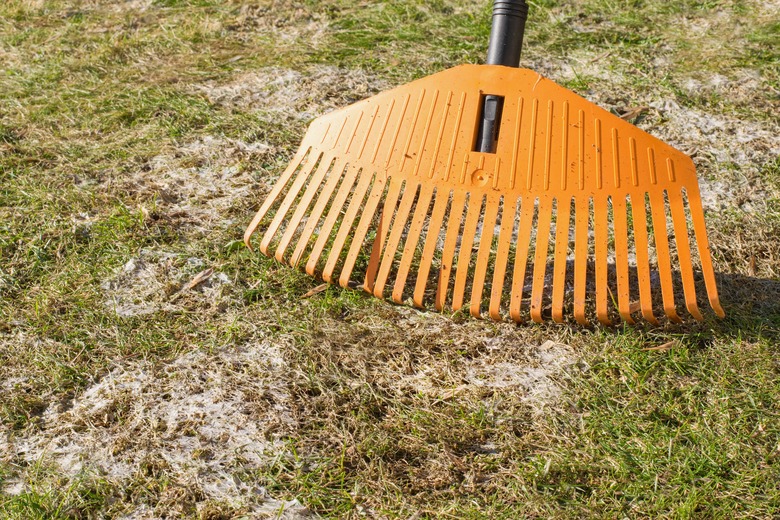How Do I Kill The Mold In My Lawn?
We may receive a commission on purchases made from links.
As a homeowner trying to keep your lawn looking good, the last thing you want to see when you step outside is a patch of mold in your yard. It might be unsightly, but the mold doesn't usually kill your lawn, although you may have some spots that are affected by the problem. The two major yard fungus types creating the moldy situation are snow mold and slime mold. Both are caused by environmental conditions conducive to their appearance.
Fortunately, dealing with the problem isn't hard or expensive. Snow molds and slime molds disappear almost as quickly as they appear and don't require fungicidal treatment. However, you can rake affected areas to break up both types and wash slime mold from your yard using a hose.
Treating Slime Mold in Yards
Treating Slime Mold in Yards
Regardless of the type of turfgrass, slime mold can affect it, especially when outdoor conditions are warm, humid, and wet during late spring and summer. The vast majority of slime molds found in yards belong to the genera Mucilago, Physarum, and Fuligo. These fungi usually don't cause lawn damage, as they only use the turf for support and gain any nutrients from decaying or dead organic material found in the thatch or in the soil. They are most common in lawns with poor drainage that remain wet and during periods of prolonged rainy weather, especially in locales that are typically humid.
Slime mold in yards appears as irregular to round patches that are about 8 inches in diameter with an oily appearance. Each patch contains thousands of pinhead-size fruiting bodies covering the outer surface of the grass blades. The fruiting bodies can take the form of orange, gray, yellow, purple, or white mold in the yard and are most likely to appear in areas that are wet and shady. However, it's not uncommon for slime molds to affect all areas of the lawn.
Most cases of slime mold in yards disappear almost as quickly as they appear, leaving without a trace after a couple of days to a week. However, if the infestation is severe, this fungus might cause the grass blades to yellow and the grass to lose a bit of vigor due to the reduction of photosynthesis because the fungus shades the grass blades.
Since slime mold leaves so quickly, fungicide treatment usually isn't necessary, but if you'd like to quickly bring your lawn back to its natural beauty, you can mow or rake the affected areas. Watering the mold patches with a forceful stream of water also breaks up the fungus. You can assist in preventing future problems by aerating heavily thatched lawns and fixing drainage problems if a particular area of your lawn remains wet.
Treating Snow Mold in Yards
Treating Snow Mold in Yards
Another type of mold in your turfgrass includes the gray and pink snow molds that develop when snow cover is heavy and prolonged. The fungus Typhula incarnata causes gray snow mold, and Microdochium nivale is the cause of pink snow mold. Both affect cool-season turfgrasses and appear when the snow melts.
Gray snow mold appears as large, white, circular patches, and the fruiting bodies resemble spiderwebs, whereas pink snow mold doesn't have a large number of fruiting bodies, and the circular patches can be up to 10 inches in diameter and colored tan, pink, or white surrounded by a copper ring of turfgrass.
Snow molds disappear as temperatures warm in spring, but affected patches may require reseeding. You can prevent the problem by not cutting your grass too short for its last mow of the season and not fertilizing with a nitrogen fertilizer late in the season. Raking the affected areas of the lawn will help break up the fungus patches, and you can apply nitrogen fertilizer to dead patches to help speed growth and recovery.
